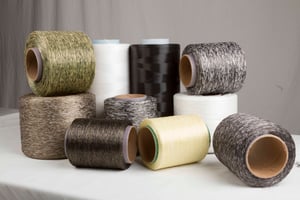 We sat down with Jen Hanna, the director of business development at Innegra™, to discuss the benefits of Innegra™ and how it can be put to the best use in a variety of applications. It’s a relatively new material to the market and many Service Thread clients have requested more information about it.
We sat down with Jen Hanna, the director of business development at Innegra™, to discuss the benefits of Innegra™ and how it can be put to the best use in a variety of applications. It’s a relatively new material to the market and many Service Thread clients have requested more information about it.
Below is what we learned in our interview with Jen. For further reading about the basic properties of Innegra™, see What is Innegra™?
Q: How was Innegra™ developed?
A: Innegra™ was developed by a chemist who saw a need in the market between polypropylenes, nylons, polyesters, and higher-performing options like Dyneema®, Spectra®, Vectran®. He saw an opportunity not just with performance but with price point.
The fiber launched in 2008/2009, which was a bad time in the U.S. economy. Shortly thereafter the company filed for bankruptcy. It’s hard to bring a new material to the market, and it’s especially hard during a recession. A new group purchased the assets and brought it back to the market in 2012 and now we have this great fiber with a ton of potential.
Q: What niche does Innegra™ fill?
A: Innegra is a high performance, high modulus polypropylene, so it does some things your standard polypropylene, nylon, or polyester may not be capable of doing. It’s also the lowest-density fiber commercially available.
It’s extremely lightweight, and in the composite industry that’s a hot topic: how to reduce weight. Whether it’s to save on fuel cost, manpower - the lighter things are, the more energy we can conserve. It also has great dielectric properties. As we expand bandwidth and go to 5G, some of the current products out there won’t be able to handle the 5G.
So it really depends on the market. Sometimes Dyneema® or Spectra® are overkill in certain applications, and you can combine them with Innegra™ to take out some of the weight, some of the cost, and still have a high-performing product.
Q: Innegra™ is tough and wear-resistant. How long does it last under typical conditions?
A: It depends on what the conditions are: a typical mountain, a typical desert, typical in space. The fiber sees a lot of different environments, so it depends on what the environment is. It’s going to last longer in colder environments than in much warmer environments, like the desert.
It has a good to excellent UV rating depending on conditions. We put a UV stabilizer in it, but most of the time things that are going to see that much UV exposure will also have a coating on the fabric. Or if it’s a composite, the Innegra™ is buried in the composite where it’s not going to see much direct sunlight.
But under typical conditions where people live, you can expect to get many years of service out of this product.
Q: Can it take direct impacts without breaking down?
A: Anything under repeated stress is going to break down a little over time. It just depends on the speed at which that breakdown occurs. Innegra™ is going to stop that acceleration of breakdown.
It is a material that is extremely tough. As far as standing up against the toughness of other fibers, I would certainly put it up against any other fibers out there.
Q: Innegra™ is ductile. What exactly does that mean?
A: It’s flexible. It’s pliable. It’s not a stiff product.
Q: Let’s talk about the dielectrics of Innegra™. Could you explain this?
A: In layman’s terms, the importance of dielectrics is allowing a signal to transfer through the material. So instead of blocking a signal, it allows it to pass through.
For example, when you’re on an airplane and you connect to WiFi, there’s a radome on top of that airplane that is receiving a signal from a satellite in space or on the ground. Innegra™ allows that to pass through.
There are all sorts of levels and gigahertz of dielectrics for signal transmission, but the bottom line is Innegra™ will allow that signal to transfer through without blocking or interfering with the signal.
Q: Earlier you mentioned that it is lightweight. Is it the lightest available?
A: It is the lightest commercially available that is published, yes.
Q: So it’s lighter than water and it floats. How water-resistant is it?
A: Innegra™ is hydrophobic material. It has less than .01% water regain. The fiber won’t be degraded. It won’t absorb that water.
Now, if you have a weave or a knit or some sort of construction or reinforcement with the fibers, it will feel wet because you have the water droplets between the weave. But as far as the fiber itself, it will not absorb any of that water.
Q: We’ve seen that Innegra™ is used in sports, including tennis, auto racing, and kayaking. Could you describe other uses of Innegra™?
A: In cycling, it is used in handlebars and wheels. It’s used in hockey sticks and masks, and lacrosse sticks and mesh. It’s used in surfing and stand-up paddleboarding as well, including paddles.
For race cars, it’s used for parts in the car for bumping and for small and larger impacts. As they have impacts from car to car, that energy damages the car and can certainly affect performance. The Innegra™ is so much more durable that it lasts longer and doesn’t cause catastrophic failure, where a part would no longer work.
Also in the ductwork, if there is an impact and the ductwork collapses, that affects the air intake. With Innegra™, air intake ducts pop right back out and air intake is not disrupted.
There are aerospace uses, but they keep that on the quiet side. We know it’s been used in NASA applications.
Q: What about protective garments?
A: One of our largest applications on the market is a puncture-resistant insole that’s used in firefighting boots. It may expand to military use as well, but for now, it’s widely used for firefighter boots.
Q: What makes Innegra™ a superior choice for certain applications?
A: Use it anywhere you’re looking for lighter weight. In some cases you can take Innegra™ and combine it with your current fiber, where they can work together to improve performance. A lot of things are overbuilt because they need thickness or protection. If you use Innegra™ in that overengineered area, sometimes you can reduce the overall weight.
It’s tougher. More durable. We have applications where the product used to last a couple of years, and now it’s lasting five, six, seven years. It tends to have a longer lifecycle.
In the signal transmission market, it makes better signal transmission a no-brainer. If you’re looking for chemical resistance, it’s very chemical-resistant. So Innegra™ is very versatile.
Q: Why would someone choose Innegra™ over a product like Kevlar®, for example?
A: We don’t speak poorly of any other material. We combine with other materials to make that material better. There are things Kevlar® can do that we can’t, and there are things we can do that Kevlar® can’t.
But the canoe industry replaced some of Kevlar® with Innegra™. Kevlar® absorbs moisture. It also breaks down in UV. So we can help with what Kevlar® was doing, and build on that by combining Innegra™ with it.
Kevlar® and Innegra™ work great at ballistic applications. Kevlar® is great at stopping that initial impact of the projectile and Innegra™ is great at dissipating that energy. So Kevlar® can take the initial blast, the higher heat, and Innegra™ can deal with the back end of the blast. So they really work well in tandem.
Q: Is there anything else you want to share about Innegra™?
A: That it’s so versatile. There’s so much Innegra can do. It works in the composite industry, it works in the textile industry, and it really depends on the problem the customer is trying to solve. We just want to be part of the conversation and have Innegra™ being discussed as an option.
Learn More About Innegra™
For more information about selecting Innegra™ for your needs, see our blog post When to Choose Innegra™ or contact the thread and yarn experts at Service Thread.



